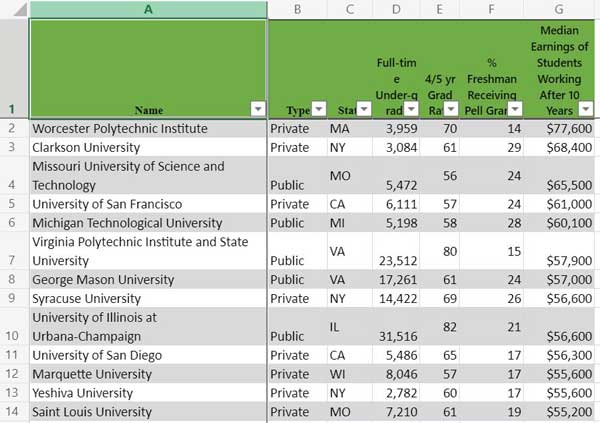 This fall’s college rankings have made earnings and return on investment a more prominent consideration when selecting a college. And with the ever increasing cost of college, this is a very reasonable reaction. However, ranking colleges by some form of graduates’ salaries has its own set of problems. Teachers simply don’t make as much as engineers or investment bankers but we need teachers. Incomes are higher in areas with higher costs of living. And these are just some of the obvious issues of ranking universities by graduates’ salaries. But this shouldn’t stop you from using the available information–just understand its limitations.
This fall’s college rankings have made earnings and return on investment a more prominent consideration when selecting a college. And with the ever increasing cost of college, this is a very reasonable reaction. However, ranking colleges by some form of graduates’ salaries has its own set of problems. Teachers simply don’t make as much as engineers or investment bankers but we need teachers. Incomes are higher in areas with higher costs of living. And these are just some of the obvious issues of ranking universities by graduates’ salaries. But this shouldn’t stop you from using the available information–just understand its limitations.
The newest income data source is from the College Scorecard. It provides median 10 year earnings of graduates who received federal student aid including student loans. According to Inside HigherEd, there are quite a few people in higher education who argue that because of the limitations, the data “may or may not provide meaningful information to students and families it was designed to help.” These tend to be the same people who have the ability to provide better information but haven’t done so which makes it hard to take their concerns for families seriously.
They are correct that there are limitations to university rankings by graduates’ salaries. Too many of such rankings are simply the reflection of majors. At the very least, the rankings should compare similar types of schools. It’s not really fair to compare liberal arts colleges with engineering schools or health profession colleges.
Yes, students need to understand that graduates with certain degrees will make more than those with others. But assuming students understand that they are likely to earn less with a liberal arts degree, it’s not unreasonable for them to want to be able to compare otherwise similar liberal arts colleges.
Therefore, I’ve decided to list the median 10 year earnings for 50-50 colleges by college type. I realize I just used a liberal arts college example but I’m going to start with research universities. There are actually three Carnegie Classifications for this type of school, Doctoral/Research, Research with high research activity, and Research with very high research activity. These categories combine for 270 institutions with 500 or more full-time undergraduates.
The average median 10 year earnings for graduates of research universities that qualify as 50-50 colleges is $48,536. For those research universities that have a 50% or better graduate rate but accept less than 50% of students, the average is $62,971. For those that have less than a 50% graduation rate, the average is $43,392.
While it’s tempting to just assume that the more exclusive colleges are providing a better return on investment, they also take wealthier students to begin with. Those that accept less than 50% of students average only 18.7% of freshman receiving Pell Grants. Institutions that have less than a 50% graduation rate have 42.4% of their freshman receiving Pell Grants. The 50-50 schools average 24.8% of freshman receiving Pell Grants.
When you compare colleges, you really should take such differences into consideration.
The following table lists all 50-50 schools classified as Doctoral/Research and the median 10 year earnings of students. Remember, these earnings are only for those who received federal aid and doesn’t account for the concentration of majors at each school. As usual, the 4 year rate is used for private schools and the 5 year for public.
50-50 Doctoral/Research Universities Ranked by Graduates’ Salaries



1 thought on “50-50 Highlights: Doctoral/Research Universities Ranked by Students’ Salaries”